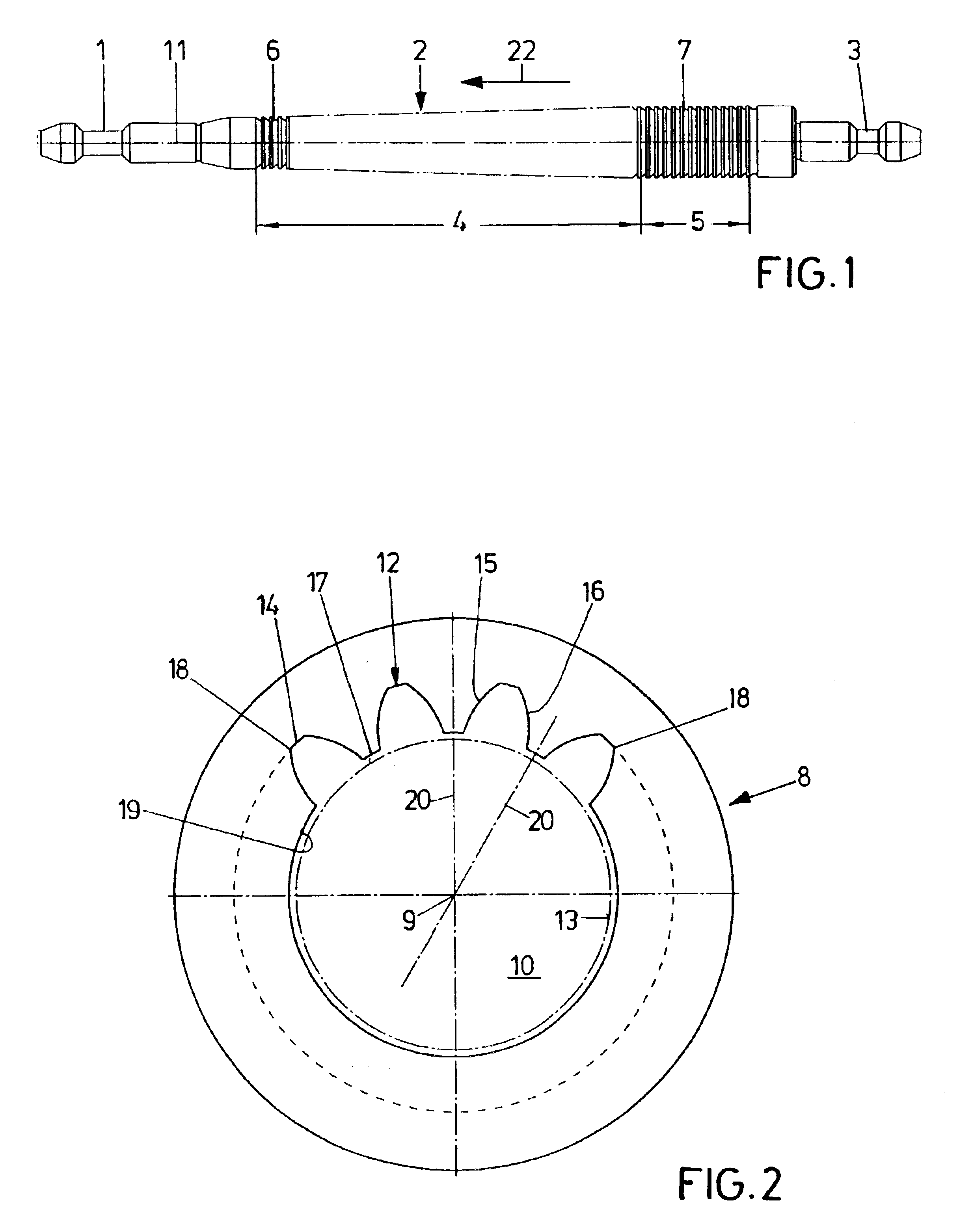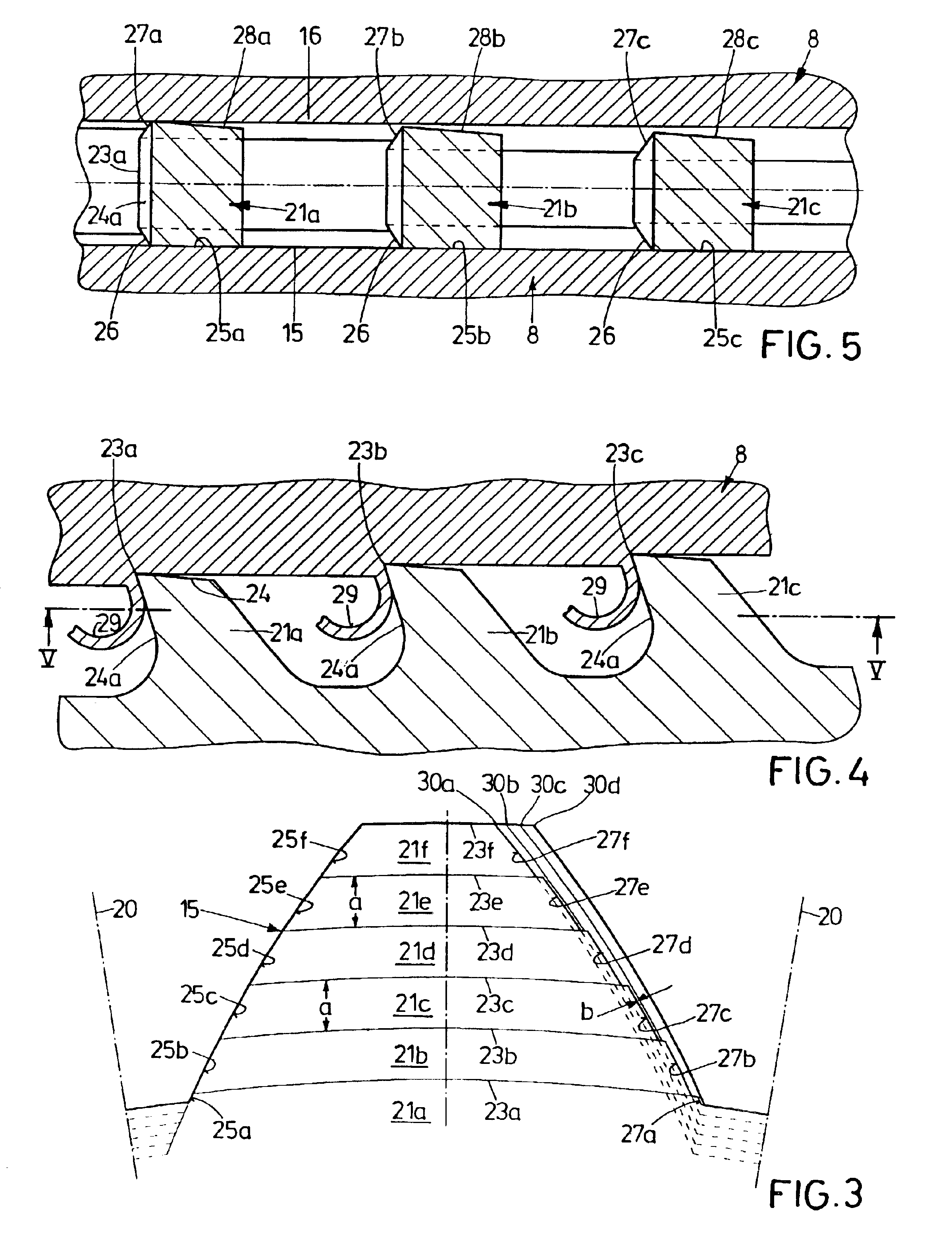Internal broach
a broach and internal technology, applied in the field of internal broaches, can solve the problems of insufficient profile accuracy and flank surface quality, negative influence of flank curve accuracy, and considerable drawbacks
- Summary
- Abstract
- Description
- Claims
- Application Information
AI Technical Summary
Benefits of technology
Problems solved by technology
Method used
Image
Examples
second embodiment
[0034]In the second embodiment according to FIGS. 6 to 8, identical parts have the same reference numerals as in the above embodiment. In as much as the parts function identically but differ in construction, the same reference numerals are used provided with a prime.
[0035]This second embodiment differs from the one specified above by the course of the flank cutting blades 27′a to 27′f of the broach cutting teeth 21′a to 21′f. They are full size cutting, having no flank pitch; the flank pitch is zero. The flank cutting blades 27′a to 27′b form the chip 29 and the flank 16 along the area of a pitch a. The course of the flank cutting blades 27′a to 27′f is precisely parallel to the course of the flank 16. Broaching to size takes place by means of the sizing teeth 30a to 30d over the full depth of the profile.
third embodiment
[0036]In the third embodiment according to FIGS. 9 to 11, parts that are identical to the mentioned embodiments have identical reference numerals, whereas parts that are functionally identical but differ in construction have the same reference numerals provided with a double prime. In this case, the flank cutting blades 27″a to 27″f are full size cutting blades. The successive broach cutting teeth 21″a to 21″f have a positive flank pitch b″, to which 027″a to 27″f cut a chip 31 over the profile depth that has been machined in each case. This is followed by a broaching-to-size operation of this flank 16, which is however not absolutely necessary. Flank full size cutting, as illustrated for the flank 16 in the embodiment of FIGS. 9 to 11, has been described in U.S. Pat. No. 5,865,569 for the job of simultaneously cutting both flanks.
[0037]FIGS. 12 and 13 on the one hand and FIGS. 14 and 15 on the other illustrate two broach cutting teeth 21g and 21h, with the represented pitch a being...
first embodiment
[0038]In modification of the first embodiment according to FIGS. 3 to 5, FIGS. 12 and 13 illustrate that the side, provided with a flank cutting blade of cutting ability, of the respective broach cutting teeth 21g, 21h has a partial flank cutting blade 32g, 32h only over the depth of some few pitches a. Therebehind, these sides are relieved surfaces 33g, 33h i.e., they are not covered by the desired flanks 16 that are to be produced; they do not engage with the work piece 8. FIGS. 14 and 15 illustrate a case in which also the flank 16 is broached to size by the broach cutting teeth 21, there being no need for final sizing. As opposed to that, the flank 16 of the embodiment according to FIGS. 12, 13 is finished by sizing. Relieving reduces the risk of clamping in the same way as the relief produced by grinding.
PUM
| Property | Measurement | Unit |
|---|---|---|
| Time | aaaaa | aaaaa |
| Time | aaaaa | aaaaa |
| Time | aaaaa | aaaaa |
Abstract
Description
Claims
Application Information
 Login to View More
Login to View More - R&D
- Intellectual Property
- Life Sciences
- Materials
- Tech Scout
- Unparalleled Data Quality
- Higher Quality Content
- 60% Fewer Hallucinations
Browse by: Latest US Patents, China's latest patents, Technical Efficacy Thesaurus, Application Domain, Technology Topic, Popular Technical Reports.
© 2025 PatSnap. All rights reserved.Legal|Privacy policy|Modern Slavery Act Transparency Statement|Sitemap|About US| Contact US: help@patsnap.com



